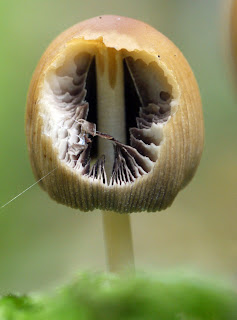This post condenses a vast number of fungi pics (believe me, you have been spared). I have really focussed on the contrast with colours, textures and shapes in this post but will of course identify the fungi as far as I can as I go along.
 |
| Amethyst Deceiver Laccaria amethystina |
 |
| more of the above which were in abundance this season |
 |
| Common Inkcap Coprinus atramentarius I am particularly fascinated by the intricate detail of the gills that can be viewed by the eaten away flesh... |
 |
| Yellow Stagshorn Calocera viscosa |
 |
| Milking Bonnet Mycena galopus |
 |
| Shaggy Parasol Macrolepiota rhacodes |
 |
| Candlesnuff Fungus Xylaria hypoxylon |
 |
| The Deceivers have been in abundance and I was intrigued to see so many with what appears to be gills pushing up through the cap |
 |
| a beautiful frilling effect as The Deceivers begin to age |
 |
| a wonderful multicoloured effect caused by slugs munching their way through the Bolete cap |
 |
| more slug effects |
 |
| Biocoloured Deciever Laccaria bicolour |
 |
| loved the textures provided by the smooth fungi growing in the cracks of the bark |
 |
| Variable Oysterling Crepidotus variabilis |
 |
| alas I came across a whole troop of Porcelain fungi as it was on it's way out, this was the best one I could salvage |
 |
| Slippery Jack Suillus luteus |







































